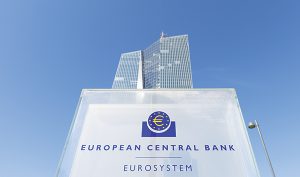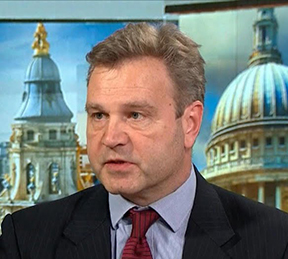It’s a sobering thought that, even after all the central bank wailing and gnashing about inflation, the European Central Bank (ECB) has yet to increase the official deposit rate from the negative 50 basis points it’s been stuck at for almost three years. When policy makers meet later this month, they should follow the example of peers elsewhere by implementing a half-point hike.
ECB President Christine Lagarde’s new mantra of gradualism, optionality and flexibility seems to have missed out the action bit. Her oft-repeated desire to raise rates initially by just 25 basis points at the July 21 Governing Council meeting is starting to look like a potential policy error. By being so prescriptive, the central bank is, in fact, reducing its flexibility.
Forward money markets are pricing in more than 200 basis points of rate hikes by June next year, so much of the hard work of repricing yields and setting expectations has already been achieved. The ECB risks not so much being behind the curve as being on a different planet. Not kicking off the rate-hiking cycle at the quarterly economic review looks like a missed opportunity.
Watching Federal Reserve Chair Jerome Powell next to Lagarde at the ECB’s forum in Sintra, Portugal, the contrast in their approaches was glaringly obvious. Helped by the super-strong US economy, Powell was confident enough to make it clear that the bigger risk was not triggering recession, but failing to control inflation expectations. In other words, interest-rate beatings will continue until inflation morale improves.
Lagarde nodded her agreement, and even responded “ditto†when asked the same final question, having spoken eloquently earlier about the need for “decisive action.†Yet there is scarce evidence of any ECB moves to combat runaway inflation, bar the gradual halting of stimulus measures. Spain was the latest European country to see its annualised inflation rate top 10%. Germany may have seen a welcome dip to 8.2%, but France’s price gains spiked sharply to 5.8%. For the euro area, the annual rate is expected to have risen to 8.5% last month from 8.1% in May. It’s hard to see where Lagarde’s confidence about controlling inflation comes from.
The same charge could equally be leveled at Bank of England Governor Andrew Bailey, who was similarly a nodding bystander to Powell’s tough rhetoric. The BOE was the first major central bank to act on rates late last year, but is now noodling in the slow lane as the Fed roars past it, despite Bailey admitting the inflation pinch is likely to affect the UK more than other major economies.
The ECB has been distracted by not having a replacement safety net in place to prevent peripheral bond yields from blowing out. Halting quantitative easing at the same time as it creates a new bond-buying vehicle may look contradictory, but the ECB needs to fight two separate fires at once. Ignoring either will just lead to more longer-term pain.
Europe is faced with Russia potentially shutting off much of its energy supply and plunging the economy into recession. But the sooner the era of negative rates is behind it, the quicker the the euro area will start to get a grip on inflation. A half-point increase later this month, taking the official rate to zero, would cement the ECB’s acceptance that dithering by raising rates in baby steps won’t help either keep growth afloat or curb consumer prices.
—Bloomberg
Marcus Ashworth is a Bloomberg Opinion columnist covering European markets. Previously, he was chief markets strategist for Haitong Securities in London
 The Gulf Time Newspaper One of the finest business newspapers in the UAE brought to you by our professional writers and editors.
The Gulf Time Newspaper One of the finest business newspapers in the UAE brought to you by our professional writers and editors.

